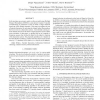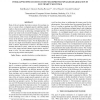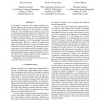8 search results - page 1 / 2 » Speaker Diarization Based on Intensity Channel Contribution |
TASLP
2011
12 years 11 months ago
2011
The time delay of arrival (TDOA) between multiple microphones has been used since 2006 as a source of information (localization) to complement the spectral features for speaker di...
ICASSP
2009
IEEE
13 years 11 months ago
2009
IEEE
In the meeting case scenario, audio is often recorded using Multiple Distance Microphones (MDM) in a non-intrusive manner. Typically a beamforming is performed in order to obtain ...
ICASSP
2008
IEEE
13 years 11 months ago
2008
IEEE
State-of-the-art speaker diarization systems for meetings are now at a point where overlapped speech contributes significantly to the errors made by the system. However, little i...
ICMCS
2006
IEEE
13 years 11 months ago
2006
IEEE
In this paper, we present a new speaker diarization system that improves the accuracy of traditional hierarchical clustering-based methods with little increase in computational co...
TASLP
2008
13 years 4 months ago
2008
Many current state-of-the-art speaker diarization systems exploit agglomerative hierarchical clustering (AHC) as their speaker clustering strategy, due to its simple processing str...



